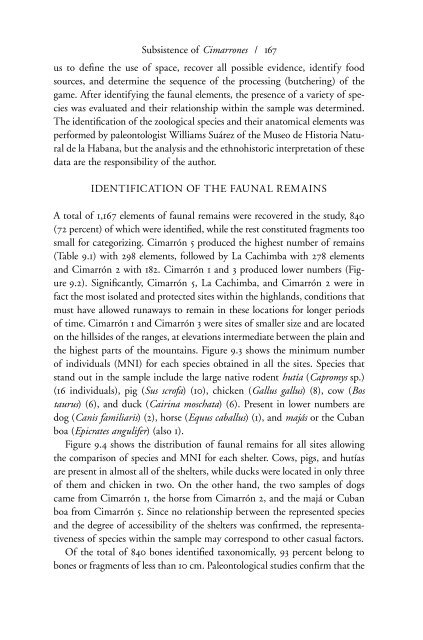Dialogues in Cuban Archaeology
by L. Antonio Curet, Shannon Lee Dawdy, and Gabino La Rosa Corzo
by L. Antonio Curet, Shannon Lee Dawdy, and Gabino La Rosa Corzo
You also want an ePaper? Increase the reach of your titles
YUMPU automatically turns print PDFs into web optimized ePapers that Google loves.
Subsistence of Cimarrones / 167<br />
us to de¤ne the use of space, recover all possible evidence, identify food<br />
sources, and determ<strong>in</strong>e the sequence of the process<strong>in</strong>g (butcher<strong>in</strong>g) of the<br />
game. After identify<strong>in</strong>g the faunal elements, the presence of a variety of species<br />
was evaluated and their relationship with<strong>in</strong> the sample was determ<strong>in</strong>ed.<br />
The identi¤cation of the zoological species and their anatomical elements was<br />
performed by paleontologist Williams Suárez of the Museo de Historia Natural<br />
de la Habana, but the analysis and the ethnohistoric <strong>in</strong>terpretation of these<br />
data are the responsibility of the author.<br />
IDENTIFICATION OF THE FAUNAL REMAINS<br />
A total of 1,167 elements of faunal rema<strong>in</strong>s were recovered <strong>in</strong> the study, 840<br />
(72 percent) of which were identi¤ed, while the rest constituted fragments too<br />
small for categoriz<strong>in</strong>g. Cimarrón 5 produced the highest number of rema<strong>in</strong>s<br />
(Table 9.1) with 298 elements, followed by La Cachimba with 278 elements<br />
and Cimarrón 2 with 182. Cimarrón 1 and 3 produced lower numbers (Figure<br />
9.2). Signi¤cantly, Cimarrón 5, La Cachimba, and Cimarrón 2 were <strong>in</strong><br />
fact the most isolated and protected sites with<strong>in</strong> the highlands, conditions that<br />
must have allowed runaways to rema<strong>in</strong> <strong>in</strong> these locations for longer periods<br />
of time. Cimarrón 1 and Cimarrón 3 were sites of smaller size and are located<br />
on the hillsides of the ranges, at elevations <strong>in</strong>termediate between the pla<strong>in</strong> and<br />
the highest parts of the mounta<strong>in</strong>s. Figure 9.3 shows the m<strong>in</strong>imum number<br />
of <strong>in</strong>dividuals (MNI) for each species obta<strong>in</strong>ed <strong>in</strong> all the sites. Species that<br />
stand out <strong>in</strong> the sample <strong>in</strong>clude the large native rodent hutía (Capromys sp.)<br />
(16 <strong>in</strong>dividuals), pig (Sus scrofa) (10), chicken (Gallus gallus) (8), cow (Bos<br />
taurus) (6), and duck (Cair<strong>in</strong>a moschata) (6). Present <strong>in</strong> lower numbers are<br />
dog (Canis familiaris) (2), horse (Equus caballus) (1), and majás or the <strong>Cuban</strong><br />
boa (Epicrates angulifer) (also 1).<br />
Figure 9.4 shows the distribution of faunal rema<strong>in</strong>s for all sites allow<strong>in</strong>g<br />
the comparison of species and MNI for each shelter. Cows, pigs, and hutías<br />
are present <strong>in</strong> almost all of the shelters, while ducks were located <strong>in</strong> only three<br />
of them and chicken <strong>in</strong> two. On the other hand, the two samples of dogs<br />
came from Cimarrón 1, the horse from Cimarrón 2, and the majá or <strong>Cuban</strong><br />
boa from Cimarrón 5. S<strong>in</strong>ce no relationship between the represented species<br />
and the degree of accessibility of the shelters was con¤rmed, the representativeness<br />
of species with<strong>in</strong> the sample may correspond to other casual factors.<br />
Of the total of 840 bones identi¤ed taxonomically, 93 percent belong to<br />
bones or fragments of less than 10 cm. Paleontological studies con¤rm that the


















